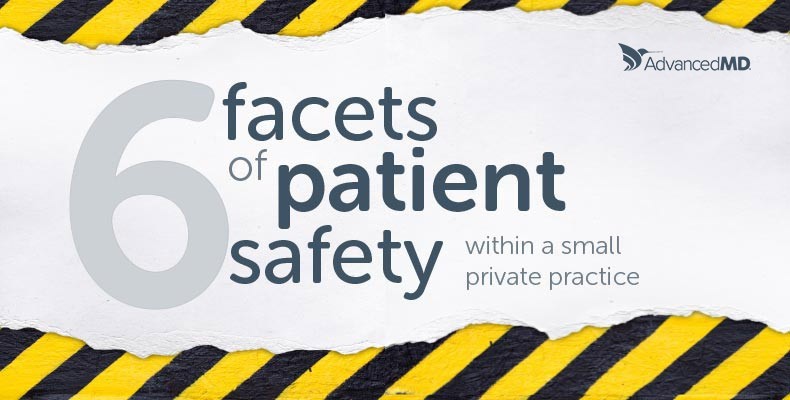
With the extended hype and press about the benefits of electronic health record (EHR) systems and the additional capabilities an EHR adds to a private practice and our healthcare system, rarely do we see those benefits in detail or what they should entail. We frequently see items such as reduced cost, improved outcomes, interoperability, or patient safety, but we never really see those items in more granular detail to determine if these systems are really worth the cost or time.
Let’s discuss patient safety, which is frequently talked about, but rarely quantified. I’ll explain six key areas of safety that not only work independently, but also work in harmony to ensure patients receive the best possible care in EHR technology.
Drug safety
The first area of safety is one that is so often quoted, as it is the easiest to understand. Drug safety is part of virtually every Healthcare IT software system. The reasons for this are many, but fall into a couple of key areas. Drug data is widely available and comes in a quantifiable form. It funnels through few narrow paths to get from a provider to the pharmacy, and ultimately, the patient, which accounts for the vast amount of drug data in quantifiable form. The data runs through a clearinghouse, which allows for consolidation and access. These interactions and patient education are well defined. There is a greater capability to ensure patient safety if quality of data and certification requirements are combined.
To be more specific, because of these processes coming together, the healthcare provider has a reasonable view into a patient’s medication history. A physician can compare that history against current medications they have on file and check for various contraindications.
Additionally, drug databases provide ample patient educational materials in multiple languages. As ubiquitous as this functionality is, there are a couple of key areas that can significantly boost the ability for a provider to proactively ensure medication safety.
Ad-hoc reporting
One potentially life saving feature available with some EHR systems is ad-hoc reporting on clinical data. On occasion, new clinical guidelines, or worse, an important drug recall will be announced. The ability to quickly search their database to find all patients with a particular condition, or those taking a particular medication, and then quickly send a message to those patients to stop taking the medication, would have significant safety implications over continuing to take the medication because they simply didn’t know.
One additional safety component is prescription adherence. With more and more of today’s healthcare plans requiring out of pocket monies to purchase prescriptions, some patients who have significant financial challenges will simply not pick them up. There are many financial assistance and discount coupon programs in place to assist patients with purchasing off-formulary or non-formulary prescription medications, but the knowledge of these programs and education of patients on these programs, should be a fundamental part of the healthcare IT solution.
Electronic laboratory results
The next focus segment on patient safety revolves around the necessity of electronic laboratory results. One of the main focus areas that has been discussed for many years is how to keep people from falling through the cracks after receiving lab results electronically into the practice. Unfortunately too many systems collect the data, but don’t do much with the results. Healthcare IT today can interrogate those lab values to determine whether or not the values are out of range, and by how much. Some systems will even show the values as being out of range. What’s missing in many healthcare IT practices today is having those abnormal values trigger actions to the physician and staff.
Examples of this include sending a high priority message to the ordering physician, indicating the lab result values are out-of-range and the practice should take notice. Taking this concept one step farther, imagine if those out-of-range values triggered a message within the patient’s portal and indicated the patient needs to contact the practice to discuss their results. The hard reality for physicians is keeping track of the many incoming results and ensuring with 100% accuracy that the abnormal labs have been thoroughly communicated to the patient. This is very difficult at best. Engaging the patient on the other end, where the patient is actively reaching back to the practice, can help ensure the follow-up required achieves the near ideal 100%.
Bi-directional communication
This last area of laboratory follow-up begins to move us toward the next area of criticality around patient safety. This is the area of bi-directional electronic messaging with the patient.
One of the great technological and literally seismic shifts in the way people communicate revolves around text messaging. Many in today’s society eschew the telephone as a primary communication platform. A substantial portion of a young couple’s courtship and dating time is spent in conversation over text messaging and the like. These electronic communication platforms are the new normal, and the healthcare industry needs to find ways to embrace these, regardless of the HIPAA and privacy issues that are in play.
Bi-directional messaging with the patient allows the patient to reach caregivers within the practice without a visit. This interrupt-driven model provides the ability for the patient to ask when it’s convenient for them and receive responses when it’s convenient for the patient. This allows a question and answer session to occur in situations where the patient may not ask, or be convenient to ask, for healthcare guidance.
Patient safety at a fundamental level cannot really be achieved without an engaged patient. Even if notified by some artificial intelligent, this means something needs to be done for the patient. If they can’t be reached to get them engaged, the provider may be legally covered due to the attempts, however, if a patient has an adverse event, it is still a tragedy that could have been averted.
Visualization
In addition to text messaging and patient portal technology, many of us within the health continuum tend to forget that we are largely delivering textual medical content that only a physician can use. This is even with the benefit of Meaningful Use 2 driving portal adoption and the ability to deliver health information to patients. A typical patient will look at lab results and see a triglyceride value that is out of range, with no idea what the value means. If instead, the triglyceride value is made available to a patient as an easy-to-read graphic, the reality of what they are looking at can be better understood by anyone of almost any age. Publishing visually graphic data to patients is much more engaging than numbers in a spreadsheet. Patients need to visually understand in a way that really can’t be communicated with numbers.
Compare how CNN or other media take advantage of visual technology when covering the presidential election. CNN shows each state with the total electoral votes, and at a glance, we know what the data means. Imagine instead a spreadsheet that showed all counties in one column, the state in another column and the candidates across the top. How hard would that information be to digest? The argument can be made that the information was presented, but it is of almost no value to someone who doesn’t deal with spreadsheets and election data for a living; which unfortunately, is a majority of the U.S. population. This is really no different than a doctor who talks about clinical information contained within most of the patient charts. MU2 requires that this data be published so the patient has access to their health information. Unfortunately, no requirement is in place to ensure the clinical data could actually be made useful to the patient.
The healthcare industry as a whole needs to start looking to other industries to see how these problems have been solved. As hard as we’re working to engage patients and provide interoperability between systems, unless we start to try to show the end user the data in a format they understand, we haven’t really solved the problem these technologies were meant to solve. It would mean better patient safety, which equates to better patient health outcomes.
Health maintenance
The final area I want to address revolves around what I refer to as health maintenance. With the huge upgrade in the amount of patient clinical and financial data we now have at our disposal, much of the effort of healthcare IT organizations revolve around monetizing this data, which in and of itself can help ensure that technology gets adopted and moves the needle in the right direction. However, again, this doesn’t really address what can be done with all of this data.
Imagine if these cloud-based healthcare IT systems looked at using the clinical data to predict which patients are likely to become diabetic. I’m sure some will say these systems have been in place for a long time. Health payors and large health systems have the kind of big data that can easily answer these clinical analytics. However, how does Dr. Smith, a solo family practice doctor, do the same? Regardless of the consolidation of physician- and hospital-owned groups, it is still a capability that is largely available only to IT departments that are doing risk analysis and modeling for their large-scale organizations.
Many smaller physician practices may not know they have enough data in their own patient populations. Provided the right tools, they can find ways to uncover the holy grail of increasing their revenue and independence, while increasing quality of care and patient safety. They will be rewarded for those efforts, instead of having those goals mandated and monitored by government regulations, which means no tools or assistance to help them to be successful.
This is really a call to arms to the healthcare IT vendors. They need to create the tools and capabilities for those who are at the point in many ambulatory healthcare settings to allow them to do the right things for the right reasons.
The six key areas on patient safety ensure patients receive the best possible care when a private practice uses an EHR technology. The benefits an EHR adds to a private practice far outweigh any costs or time required to learn the technology. The benefits include reduced costs, improved outcomes, interoperability between other technologies, and of course, patient safety, which is of utmost importance.
Stephen Dart is Chief Product Manager for the Clinical Center of Excellence at AdvancedMD. A former Microsoft Alumni and engineer, he also holds an MBA from Washington State University and has been a key figure in electronic medical records development since 1993. He developed one of the first windows based EHR products in 1997 and was awarded a patent on using a template architecture to automatically calculate E&M codes based on clinical documentation. He was the architect of the move from the windows platform to the Web for the AdvancedMD EHR product suite and is actively involved in the design, architecture and research in all things for physicians and patients within the Clinical COE at AdvancedMD.

Stephen Dart is Chief Product Manager for the Clinical Center of Excellence at AdvancedMD. A former Microsoft Alumni and engineer, he also holds an MBA from Washington State University and has been a key figure in electronic medical records development since 1993. He developed one of the first windows based EHR products in 1997 and was awarded a patent on using a template architecture to automatically calculate E&M codes based on clinical documentation. He was the architect of the move from the windows platform to the Web for the AdvancedMD EHR product suite and is actively involved in the design, architecture and research in all things for physicians and patients within the Clinical COE at AdvancedMD.

